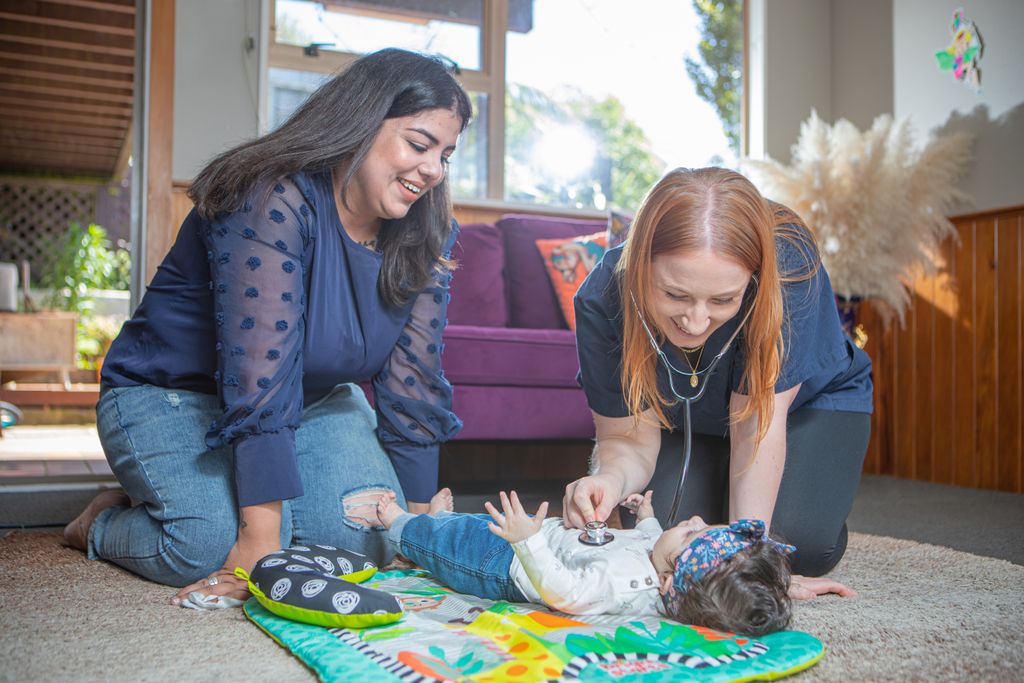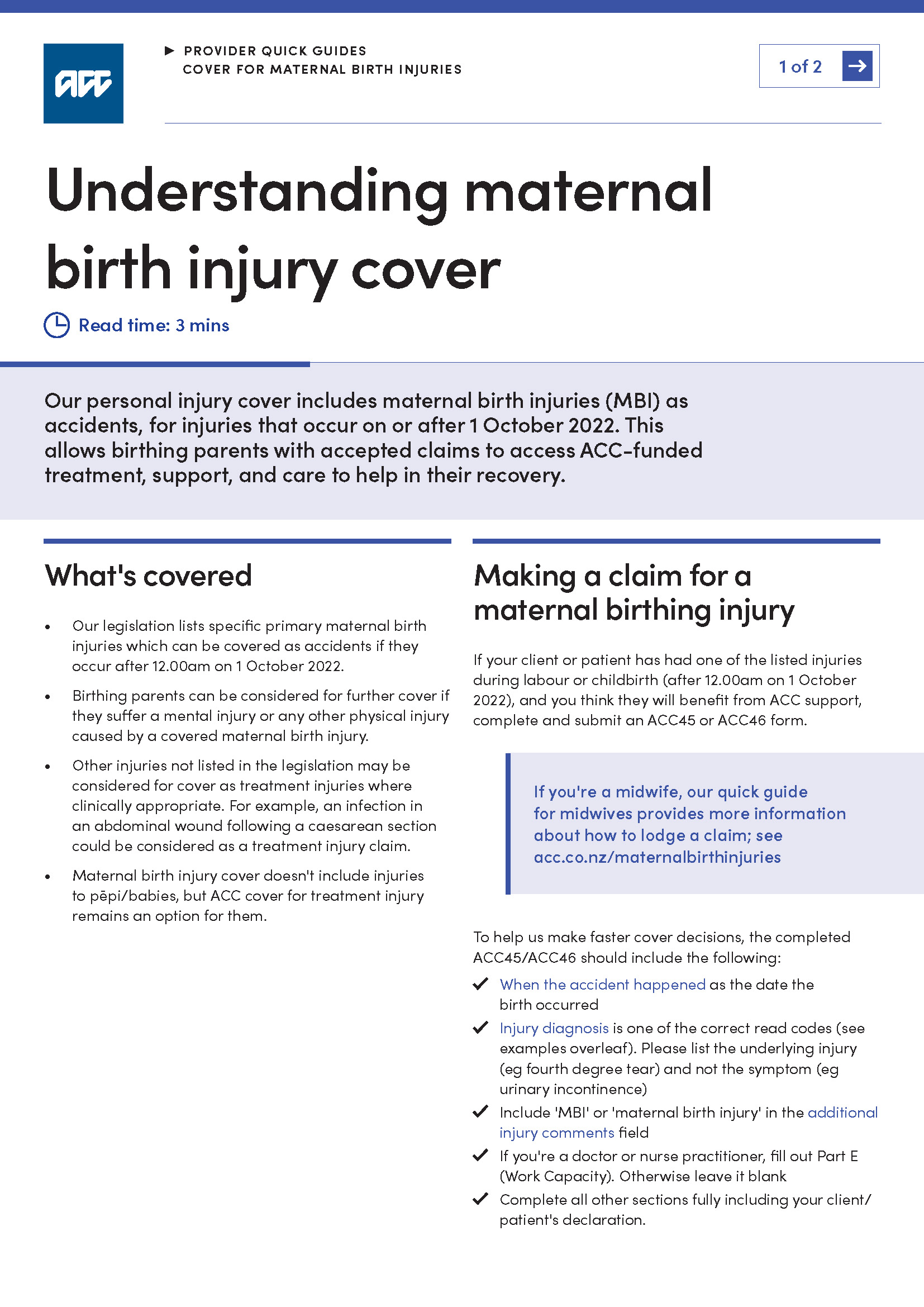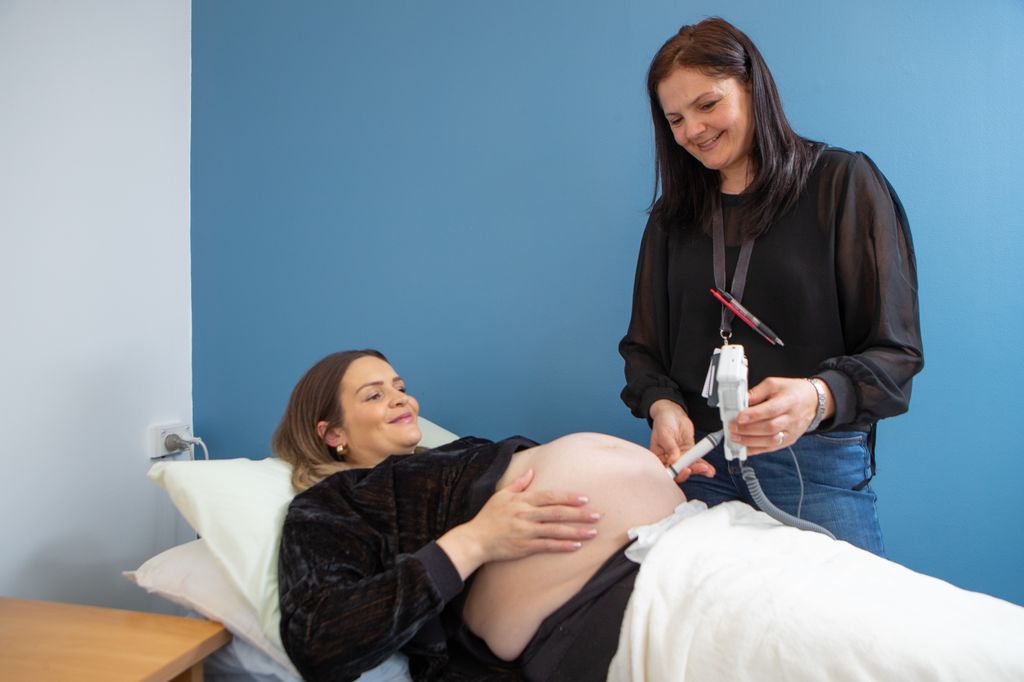Christmas and New Year opening hours and pay dates
We have reduced hours over the holiday period and are closed on public holidays. Your payments from us may be paid early. See more details.
Ngā wharanga whakawhānau pēpiMaternal birth injuries
We’re supporting those who experience certain maternal birth injuries during labour or delivery on or after 1 October 2022. Understand what health providers need to know to lodge claims and provide treatment for a maternal birth injury.

The basics of maternal birth injury cover

Understanding maternal birth injury cover quick guide
From 1 October 2022 our accident cover includes specific injuries birthing parents can experience from the beginning of labour through to delivery of the pēpi/baby.
That means those who give birth from 1 October 2022 onwards and who have a covered injury can access the appropriate support, treatment, and care through the Accident Compensation Scheme to help their recovery and return to independence.
Background
Maternal birth injuries were included as part of our accident cover as result of the Accident Compensation (Maternal Birth Injury and Other Matters) Amendment Bill. The legislation was introduced by Minister for ACC Hon Carmel Sepuloni and passed its Third Reading on 27 September 2022.
The legislation updates the definition of ‘accident’ to include “a force or resistance internal to the human body at any time from the onset of labour to the completion of delivery”. It also includes a specific list of injuries which are eligible for cover and requires ACC to regularly review the listed injuries to ensure they remain appropriate.
What injuries are covered?
Research indicates many birthing parents will experience an injury during labour and childbirth. While many of these will resolve with standard maternity care or require low-level support, some will need more significant treatment and care.
The legislation sets out a specific list of injuries which are now eligible for cover. These are:
- Anterior wall prolapse, posterior wall prolapse, or uterine prolapse
- Coccyx fracture or dislocation
- Levator avulsion
- Obstetric anal sphincter injury tears or tears to the perineum, labia, vagina, vulva, clitoris, cervix, rectum, anus, or urethra
- Obstetric fistula (including vesicovaginal, colovaginal, and ureterovaginal)
- Obstetric haematoma of pelvis
- Post-partum uterine inversion
- Pubic ramus fracture
- Pudendal neuropathy
- Ruptured uterus during labour
- Symphysis pubis capsule or ligament tear
- A caesarean section is not a maternal birth injury covered by this legislation. If the client has one of the listed birth injuries, then ACC is able to provide cover and entitlement aligning to that injury.
As is currently the case, we can accept cover for injuries which are the direct result of the original injury (consequential injuries). Birthing parents can be considered for cover if they suffer a mental injury or any other physical injury caused by a listed maternal birth injury.
The cover we provide for injured New Zealanders is set out in the legislation which governs how we operate, the Accident Compensation Act 2001.
The update to include maternal birth injuries provides cover for listed injuries experienced on or after 1 October 2022, meaning birthing parents who suffered injuries before this date will not be eligible. A claim for treatment injury remains a possibility where appropriate, for example a wound infection related to a caesarean section birth.
Injuries to pēpi (babies) which may happen during labour or delivery have not been included in this change, but treatment injury cover remains an option for them.
Episiotomies are not covered under this proposed legislation. This procedure is performed by a registered health professional and wouldn’t meet the updated definition of an ‘accident’ being caused by a force or resistance internal to the human body at any time from the onset of labour to the completion of delivery. These would also not be considered appropriate as a treatment injury claim. When conducted under the appropriate guidelines, an episiotomy is considered a necessary surgical incision.
Who can lodge a claim or diagnose a birth injury?
There are a range of ACC-registered health providers who can submit a claim for a maternal birth injury on behalf of their patients. This needs to be done within the provider's scope of practice. If an injury is outside your scope of practice, you’ll need to refer your patient to an appropriate provider who can support.
| Covered maternal birth injuries | General practitioner |
Obstetrician/ Gynaecologist |
Nurse practitioner | Registered nurse | Urologist | Pelvic health physiotherapist | Physiotherapist | Chiropractor | Osteopath | Midwife |
|---|---|---|---|---|---|---|---|---|---|---|
| Anterior wall prolapse, posterior wall prolapse, or uterine prolapse | Yes | Yes | Yes | Yes | Yes | Yes | ||||
| Coccyx fracture or dislocation | Yes | Yes | Yes | Yes | Yes | Yes | Yes | Yes | Yes | |
| Levator avulsion | Yes | Yes | Yes | Yes | Yes | Yes | ||||
| Obstetric anal sphincter injury tears or tears to the perineum, labia, vagina, vulva, clitoris, cervix, rectum, anus, or urethra | Yes | Yes | Yes | Yes | Yes | Yes | Yes | |||
| Obstetric fistula (including vesicovaginal, colovaginal, and ureterovaginal) | Yes | Yes | Yes | Yes | Yes | |||||
| Obstetric haematoma of pelvis | Yes | Yes | Yes | Yes | Yes | |||||
| Post-partum uterine inversion | Yes | Yes | Yes | Yes | Yes | |||||
| Pubic ramus fracture | Yes | Yes | Yes | Yes | Yes | Yes | Yes | |||
| Pudendal neuropathy | Yes | Yes | Yes | Yes | Yes | |||||
| Ruptured uterus during labour | Yes | Yes | Yes | Yes | Yes | |||||
| Symphysis pubis capsule or ligament tear | Yes | Yes | Yes | Yes | Yes | Yes | Yes |
Getting help after a birth injury
To help providers talk to their patients about support for a birth injury, we've created some resources for māma, birthing parents and whānau.
Our brochure provides advice about what type of help may be available for a covered injury, when to seek help, and includes a list of organisations and helplines which can provide more information.

